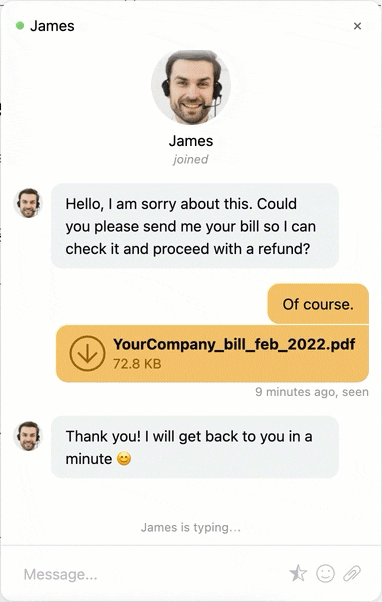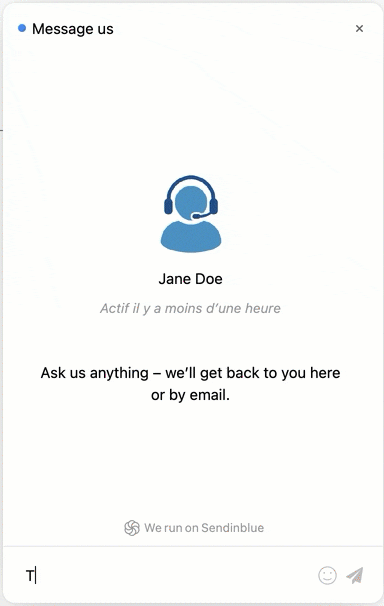Implementing a chat widget is a way to increase your order value by 60%. Without a doubt, you need to have one on your website. The question is, should it be a chatbot or a live chat?
Choosing between these two isn’t easy. Both chatbots and live chat offer a number of benefits, resulting in a positive customer experience and increased profits. However, each comes with its challenges and limitations.
In this article, we’ll show you how live chat solutions and chatbots differ, highlight the pros and cons of each option, and help you choose the right solution for your company when looking to get started with conversational marketing.
The Difference Between Live Chat vs Chatbot
First, let’s define live chat and a chatbot.
Live chat is a customer communication solution embedded оn your website. It’s a tool for direct messaging through which site visitors get instant support from customer service agents. It stands in for real-life sales assistants or phone support. Your customers get answers to their questions in real-time without leaving your website.
A chatbot is an application that automatically replies to customer queries without real human interaction. There are two main types of chatbots: AI-driven bots and rule-based bots. Conversational AI chatbots use machine learning and natural language processing (NLP) technology to simulate human conversations while rule-based ones hold basic conversations based on predefined flows.
The key difference between live chat and a chatbot is who leads the conversation — a human agent or a bot. So are those solutions exact opposites? Let’s dive deeper.
Live Chat vs Chatbot Comparison
Here’s a side-by-side comparison of the key features of live chat and chatbots.
Chatbot vs Live Chat: Pros and Cons
Chatbot
Consumers seem to love chatbots. 40% prefer them to talking to humans. But what about you, the business owner?
On one hand, chatbots offer many advantages for business:
- Reduced wait time. Users don’t have to wait for an agent to answer their questions – they get instant replies from a bot.
- Constant availability. Customer support is available all day, every day.
- No chats missed. You don’t miss a single request because bots resolve them automatically.
- More productive teams. Customer service and support teams aren’t distracted by repetitive messages and can focus on more important tasks, like complaint handling and problem-solving.
- Cost savings. When the majority of customer questions are handled automatically, you’ll need fewer support reps.
- Improved customer journey. Proper automation can provide a smoother customer journey.
On the downside, chatbots come with some drawbacks:
- Difficult setup. It takes a lot of time and effort to set up a sophisticated chatbot solution powered by artificial intelligence.
- Lack of flexibility. Rule-based chatbots — which are mostly used by small businesses — often offer limited scenarios. When an unexpected scenario happens, a chatbot won’t be able to follow the conversation. This can lead to customer frustration and low satisfaction rates.
- Lack of human touch. Bots can’t tailor each conversation, add empathy or provide complex solutions.
- No instincts = Lost opportunities. An experienced sales rep can always recognize upsell and cross-sell opportunities. But chatbots lack this instinct. So chatbots can’t do it all.
Related: Chatbot Examples
So is a chatbot a good addition to your toolkit? Definitely. Can it handle the whole customer service load? Unlikely.
Let’s look at live chat too before you pick a solution for your business.
Live Chat
What benefits to expect from live chat?
- Easy setup. To get started, you just need to embed a chat widget on your website. All-in-one marketing automation platforms offer that. Learn more about chat on Brevo.
- Improved support experience. Answering questions in real time and supporting them live throughout the buyer journey makes for happier customers.
- Better customer relationships. Customer support reps can take actions and make decisions that strengthen loyalty and improve brand reputation (e.g. offering complimentary gifts or discounts).
- Higher order value. In a one-on-one conversation with a prospect, a human support agent can better understand what they’re looking for and give more relevant recommendations.
- Customer insights. Regular interaction with prospects and customers via live chat gives valuable insights into their most common problems. Use them to resolve repetitive issues and improve customer engagement.
- Effective problem solving. Live chat agents’ capability isn’t limited to predefined flows — they can resolve complex, unique issues that bots can’t tackle.

At the same time, you should be aware of live chat’s limitations:
- Wait time. Your customer support reps won’t be able to reply to every request immediately. If they take too long, users will leave and your brand reputation might suffer.
- Limited availability. Chat support hours depend on the work hours of your support reps. When they sign off for the day, your live chat goes offline. If you want to serve your customers 24/7, you need to build several support teams in different time zones.
- Higher costs. The bigger the workload, the more agents you need on your team. Costs go up with the growing headcount.
- Prone to errors. Humans are more likely to make mistakes than chatbots. Misspelling a name when replying or closing the wrong chat will happen. That’s the price to pay for authenticity and empathy.
- Limited capacity. People can’t handle countless conversations at the same time. So capacity will depend on the incoming load, the complexity of the inquiries, and the agents’ efficiency.
Live chat is the easier to implement option, but it hits a wall at a certain point. So far, it looks like it’s best to combine both for your conversational strategy to cover all your bases.
Read more: Best Live Chat Widgets for Your Website (Paid & Free)
When to Use Chatbots and When to Use Live Chat?
Live chat results in customer satisfaction levels of up to 84%. In the meantime, 80% of customers say interacting with a chatbot has been a positive experience for them. Without a doubt, both live chats and chatbots can be beneficial for business. But how to set them up?
Use live chat when…
You sell high-ticket items or services
When buying something expensive, customers expect top-notch customer service. Live chat agents can help them make a buying decision, nudging them through the sales funnel. It’s like personal sales assistance at the store.
You want to work on customer success
If your business strategy relies on upselling and retention of existing customers, live chat can be your customer success tool.
Customer success is all about building strong customer relationships to improve retention and increase revenue from existing customers. To create a genuine connection with your customers, it’s best to offer live chat support by humans rather than bots.
You regularly have to handle complex customer issues
If that’s a daily reality for your business, having a quick and efficient communication channel to resolve them can increase customer satisfaction. Live chat agents can handle each query individually and tailor a solution for each customer unlike chatbots, bound by flows.
You want to increase the average order value (AOV)
A bot won’t be able to recognize cross-sell and upsell opportunities as a customer service rep will. Humans are more sensitive to subtle clues in the customer’s choice of words and mood. Plus, it’s harder to be impolite to a fellow human than it is to just ghost a chatbot.
Read more: The 10 Best Live Chat Software Compared
Use a chatbot when…
You want to always be available to customers
Do you need to stay online 24/7? If your target markets are on different continents but your entire team is located in one time zone, chatbots will cover outside working hours. Even the most basic chatbot welcoming website visitors and saving their contact details is more effective than a live chat in offline mode.
You can’t afford to scale your customer service team
The more chat requests you get, the more agents you need to hire. However, that’s often a problem for small businesses, trying to do it all. Chatbots can take the simple conversations so fewer agents are actually able to tackle the complex issues.
You get the same questions over and over
Maybe you get a lot of messages but they all come down to the same frequently asked questions (FAQ)? Chatbots are perfect for that. Automate those answers and don’t waste more time!

You have a clear understanding of your customer journey
If you’re confident you can predict customer pain points, common questions, and roadblocks on the way to a purchase decision, you’re ready to set up a chatbot and streamline the process. Thus, your chat widget will turn into a lead generation and conversion tool.
What if you don’t handle that many incoming requests from prospects and customers? Then you can use your chat widget for lead generation. Set up a chatbot that will welcome site visitors and drive attention to your lead magnet, and you’ll generate a lot of inbound opportunities.

… Or use a hybrid model
The main takeaway here is clear: live chat and chatbots complement each other as marketing tools. It shouldn’t be “chatbot vs live chat” but rather chatbot and live chat.
Small and ecommerce businesses especially cna have the best of both worlds by using hybrid chatbots.
Hybrid chatbots are cost-effective solutions that combine the use of bots for automatic handling of simple conversations and live agents for resolving complex questions.
In this setup, all users are typically welcomed by a bot that follows a predefined flow, but they can always choose to talk to a real person. This way, chatbots take a load off support agents so they can focus on more critical requests.
With Brevo Conversations, you can set up chatbot scenarios to automatically handle frequently asked questions before they’re transferred to support agents if needed. An intuitive editor allows you to map out customer conversations in a few clicks without coding. Free up your support team while improving customer satisfaction rates with quick answers. Pricing starts at $15 per agent seat, all features included.







